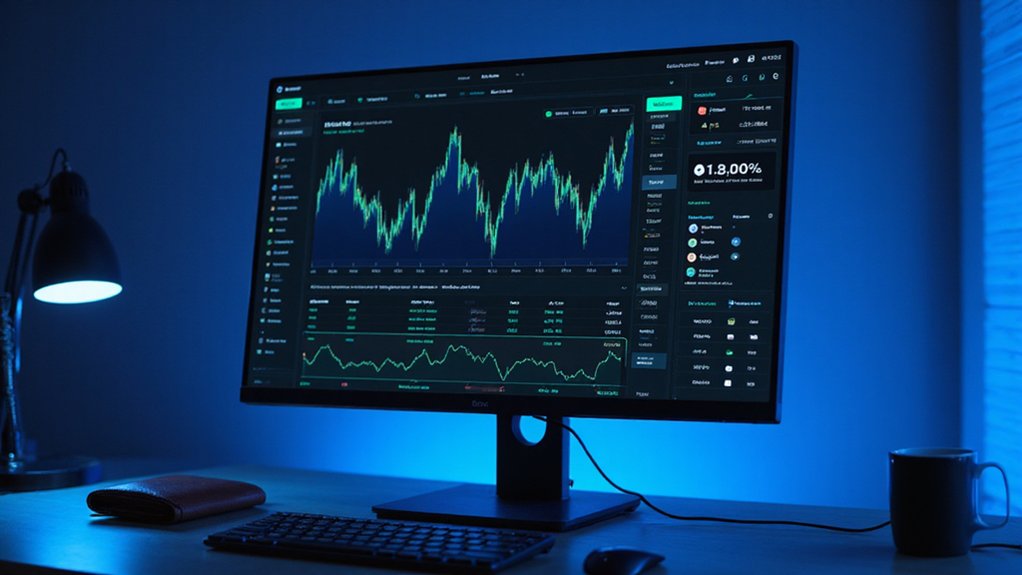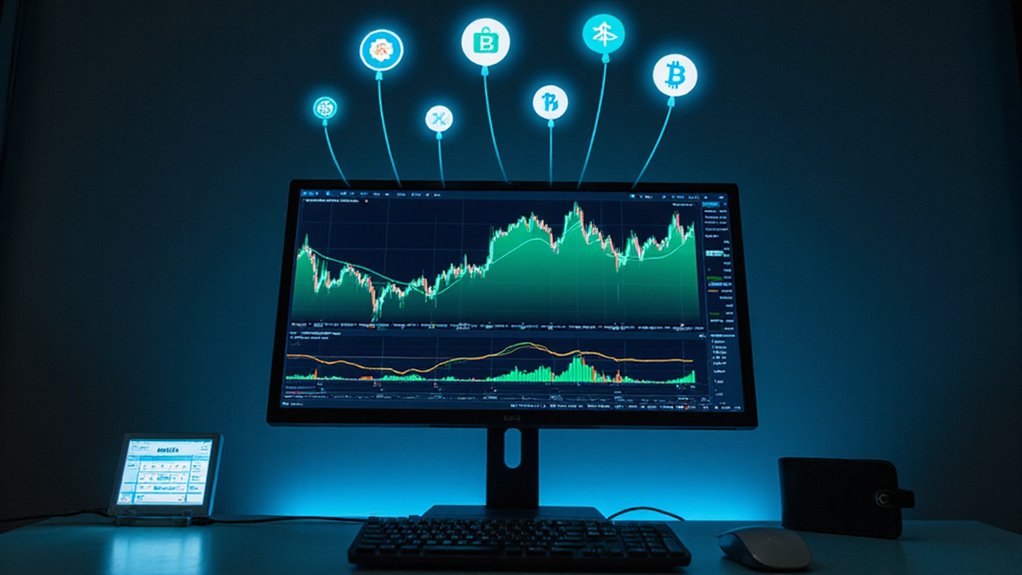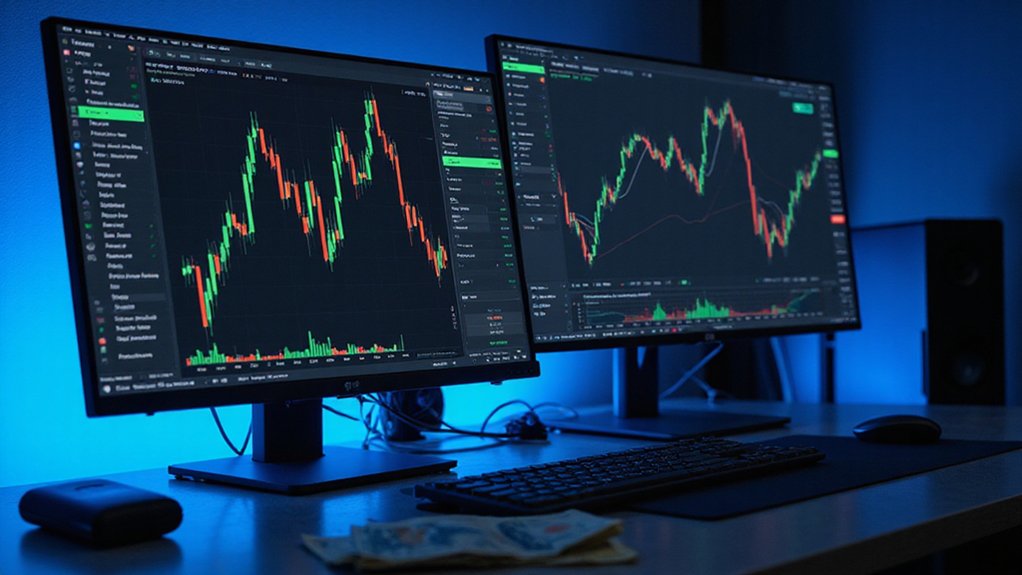Bibox Exchange, established in 2017, offers traders an AI-enhanced platform supporting over 500 cryptocurrencies. Beyond standard spot trading, the exchange features margin options, automated bots, and grid trading functionality—all with reasonable 0.1% transaction fees. Security measures include mandatory KYC verification with daily withdrawal limits up to 10 BTC. The platform’s copy trading and third-party integrations accommodate both novices and experienced traders seeking algorithmic advantages in volatile markets. Further exploration reveals additional nuances worth consideration.

The emergence of Bibox in the cryptocurrency exchange landscape represents a confluence of artificial intelligence and trading functionality that has, since its 2017 founding by Aries Wang, carved out a distinctive niche in the global digital asset marketplace.
Operating from strategic bases in Estonia, Hong Kong, and Singapore (though particularly absent from U.S. markets), Bibox has positioned itself as a centralized exchange that—somewhat paradoxically—incorporates decentralized elements allowing users to maintain control over their digital holdings.
The platform’s AI-enhanced algorithms ostensibly optimize trading decisions across more than 500 supported cryptocurrencies and 250+ trading pairs.
AI-driven optimization across half a thousand cryptocurrencies defines Bibox’s algorithmic approach to digital asset trading.
These technological underpinnings manifest in practical offerings like automated trading bots and grid trading functionality, which enable users to establish price parameters for automatic execution—a feature particularly valuable in volatile markets where timing often proves consequential.
Bibox presents traders with an extensive suite of options: spot trading for immediate transactions, margin trading for the leverage-inclined, and customer-to-customer mechanisms facilitating direct user exchanges.
The platform’s native BIX token oils these transactional wheels, while its intuitive interface accommodates both neophytes and seasoned crypto veterans.
Educational resources further bridge this knowledge gap, though one wonders if any tutorial can truly prepare users for crypto’s notorious unpredictability.
From a cost perspective, Bibox maintains competitive positioning with transaction fees hovering at 0.1% for certain trades and zero-fee deposits.
Withdrawal costs fluctuate according to currency type, with KYC-verified users enjoying elevated daily withdrawal limits of up to 10 BTC—a generous ceiling that would accommodate all but the most substantial traders.
The exchange’s copy trading functionality merits particular attention for allowing users to mirror successful strategies, effectively outsourcing trading decisions to presumably more experienced hands.
This feature, combined with multiple data visualization options and an adaptive interface, demonstrates Bibox’s commitment to accessibility without sacrificing analytical depth.
While Bibox offers strong trading tools, it lacks the depth of BitMart’s NFT marketplace functionality which provides creators and collectors with a dedicated platform for digital asset transactions.
Whether this AI-driven approach genuinely outperforms human intuition remains—like so much in cryptocurrency—an open question worthy of continued observation.
The platform enforces mandatory KYC verification for all users, which significantly enhances security and helps prevent fraud and money laundering activities on the exchange.
Traders looking to automate their strategies can utilize several third-party options as Bibox supports integration with three spot bots including Holderlab, TrendSpider, and Shrimpy.
Frequently Asked Questions
Is Bibox Regulated in the United States?
Bibox Exchange is not regulated in the United States.
Despite implementing KYC verification procedures—a nod to compliance fundamentals—the Hong Kong-based platform operates without registration or oversight from key U.S. regulatory bodies like the SEC, FinCEN, or CFTC.
While Bibox has made regulatory inroads in Europe (notably with its EU platform backed by Swiss banking partnerships), American investors should note the conspicuous absence of U.S.-specific consumer protections or regulatory safeguards on this decentralized exchange.
How Does Bibox’s Fee Structure Compare to Other Exchanges?
Bibox’s fee structure positions itself competitively among exchanges, featuring a standard 0.1% maker/0.2% taker arrangement that—rather uniquely—can be slashed by up to 50% through BIX token holdings rather than trading volume.
While Binance and KuCoin offer similar maker fees, they tie discounts to trading activity instead of token ownership.
The absence of deposit fees proves advantageous, though the conspicuous lack of transparency regarding withdrawal costs remains a curious omission in their financial disclosure.
What Security Measures Does Bibox Implement to Protect User Funds?
Bibox implements several security measures to protect user assets, including multi-factor authentication (Google 2FA and SMS verification), a funds password requirement for withdrawals, and offline storage for the majority of digital assets.
Their infrastructure incorporates SSL encryption and a microservices design, while purportedly leveraging AI technology to monitor suspicious activities.
Despite these technical safeguards, user feedback suggests mixed results—with trust scores revealing persistent concerns about the exchange’s overall security posture and transparency.
Can I Trade Directly From My Hardware Wallet on Bibox?
No, traders cannot directly interface hardware wallets with Bibox.
The exchange—despite its AI-enhanced algorithms and decentralized structure—requires users to transfer their cryptocurrencies from hardware storage to their Bibox account before executing trades.
This somewhat cumbersome intermediary step (a common limitation across many exchanges) necessitates that users manage their assets through the platform’s digital infrastructure rather than maintaining the enhanced security that direct hardware wallet integration would provide.
Does Bibox Offer Tax Reporting Tools for Traders?
Bibox doesn’t offer native tax reporting tools within its exchange environment—a curious omission given the regulatory scrutiny crypto faces these days.
Users must rely on third-party solutions like ZenLedger, CoinLedger, or Koinly to properly document their trading activities.
While Bibox excels at providing advanced trading features (copy trading, automated bots), tax compliance remains firmly in the DIY category, requiring manual data exports and integration with specialized software capable of generating the requisite tax forms across jurisdictions.









